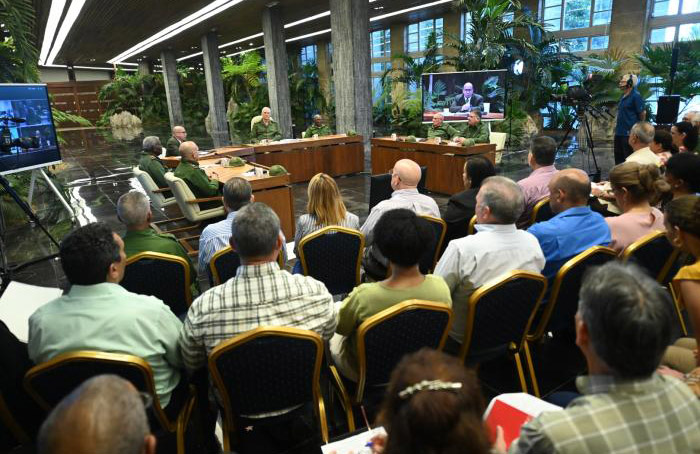
Havana, October 30. - The National Defense Council evaluated the preliminary damages after Hurricane Melissa's passage through a videoconference with the provinces where the main impacts occurred: Santiago de Cuba, Granma, Holguín, Las Tunas, and Guantánamo.
From the Palace of the Revolution, the meeting was led this Wednesday by Miguel Díaz-Canel, President of the National Defense Council, who highlighted that the ability to protect the population from the meteorological event “is not a miracle,” but the result of “preparation, organization, discipline, solidarity, unity, and the will of a people in Revolution.”
According to a report today on the Presidency's website, as the main phenomena associated with the meteorological event's passage through the eastern part of the country for about six hours, Celso Pazos Alberdi, director general of the Institute of Meteorology (Insmet), emphasized the intensity of the rain it brought, even before touching Cuban soil; the hurricane-force winds, especially in Santiago de Cuba and Granma, as well as coastal surges with waves up to eight meters high in some places.
From Santiago de Cuba, the province where Melissa made landfall in eastern Cuba, Beatriz Johnson Urrutia, president of the Provincial Defense Council, noted that the situation there is complex, as even though good preparation was achieved before the hurricane's impact, the intensity of its winds caused multiple impacts.
Still unable to provide figures, she said that preliminarily, the main damages are concentrated in fallen trees; communications services; the electrical system, especially secondary networks; total and partial building collapses, mainly in the municipalities of Palma Soriano and Guamá, as well as in agriculture, in crops like coffee, plantain, and cassava.
She also announced that the Santiago airport is ready to carry out cargo operations once it is decided to start them.
With more than 126,000 people evacuated and a tense hydrometeorological situation, Granma province was another one strongly affected by Melissa's impact. In that regard, Yudelkis Ortiz Barceló, president of the Provincial Defense Council, informed the National Defense Council that all the rivers and streams in the territory have overflowed their banks, which poses greater challenges at this time.
While all 13 municipalities received the hurricane's impacts, she noted that the most affected have been Bartolomé Masó, Buey Arriba, Jiguaní, Cauto Cristo, and Bayamo; meanwhile, due to flooding, the territories of Río Cauto and Dos Ríos are isolated.
As preliminary damages, she referred to downed trees, electrical cables and poles, as well as partial and total roofs.
Joel Queipo Ruiz, president of the Holguín Provincial Defense Council, the province where Melissa exited Cuban territory this Wednesday, explained that it was necessary to protect more than 275,000 people.
Regarding the hydrometeorological situation, he commented that a high volume of water has accumulated in a very short time, which has forced 13 of the province's reservoirs to be spilling at the time of the meeting.
Among the confirmed damages, he referred to several partial and total roofs, as well as 30 homes in the Cueto municipality that were underwater. In plantain, corn, cassava, and vegetables, the main agricultural impacts are evident.
Also in the Guantánamo municipalities of Caimanera, Guantánamo, El Salvador, Niceto Pérez, and Yateras, according to Yoel Pérez García, president of the Provincial Defense Council, high volumes of precipitation had occurred.
The main impacts on the economy, he commented, were being tallied in coffee crops; fallen trees; total and partial roof collapses; electrical line poles; roads, especially in the mountains; and communications services.
Similar damages were being recorded in the afternoon of this Wednesday in Las Tunas province, from where Osbel Lorenzo Rodríguez, president of its Provincial Defense Council, said that the main agricultural damages were in the productive hub of the Jesús Menéndez municipality, in crops such as plantain and corn.
Also in that northern Las Tunas municipality is the Juan Sáez dam, which remains under constant monitoring and is already easing, as in addition to the high volume of water accumulated in it, waters from surrounding territories continue to arrive and increase its filling. (Text and photo: ACN)